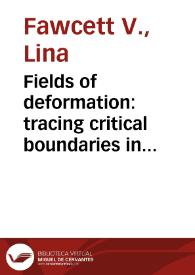Fields of deformation: tracing critical boundaries in architectural practice = Campos de...
Contenido de la obra
Contenido de la obra
Registro bibliográfico
Registro
- Título: Fields of deformation: tracing critical boundaries in architectural practice = Campos de deformación: trazando márgenes críticos en la práctica de la arquitectura
- Autor: Fawcett V., Lina
- Publicación original: 2007
- Descripción física: PDF
-
Nota general:
-
If architecture has succeeded the natural impulse of evolution and demonstrated its everchanging creative power, urbanism has challenged its operationality by revealing a logic that surpasses any established concepts within the field. New urbanisms today are understood by weakening public life, changing the nature of the streets and modifying the human scale. Furthermore, the emergent post-urban life appears unmanageable due to conditions never diagnosed before: edge cities, peripheries, nodality and disarticulation seem problematic to conceptualize.
What is it about the challenge of architecture capable to deploy a logic that drives urban design with a certain direction? Architecture can expand its potential design approaches through the investigation of its own rationality in order to find new sources that intersect emerging urban landscapes. The façade performs as a critical surface that articulates urban affects and provides a positive understanding of the street-grid as a persistent and flexible planning instrument along time. If the plan is not sufficient anymore, by securing its spatial hierarchies the building skin becomes significant to a contemporary discussion where architecture gains an instrument to overcome the difference.
The dialogue amongst architectural design process is not reducible to a fixed set of values but to opening up its own disciplinary boundaries. It intends to rethink these borders in new terms utilizing few notions and examples that have proven as techniques of formal stability within architecture, as opposed to the diffuse and complex transformational processes of the city. Paradoxically, it is inside architecture where non-static surfaces of composition open the field to creative processes, since they are by nature given to experimentation.
-
If architecture has succeeded the natural impulse of evolution and demonstrated its everchanging creative power, urbanism has challenged its operationality by revealing a logic that surpasses any established concepts within the field. New urbanisms today are understood by weakening public life, changing the nature of the streets and modifying the human scale. Furthermore, the emergent post-urban life appears unmanageable due to conditions never diagnosed before: edge cities, peripheries, nodality and disarticulation seem problematic to conceptualize.
- Notas de reproducción original: Digitalización realizada por la Biblioteca Virtual del Banco de la República (Colombia)
-
Notas:
- Resumen: Architecture; Arquitectura; Entorno; Facades; Fachadas; Hierarchies; Jerarquías; Landscape; Nodality; Nodos; Periferias; Peripheries; Planos de composición.; Surfaces of composition; Urbanismo; Urbanism
- © Derechos reservados del autor
- Colfuturo
- Forma/género: tesis
- Idioma: inglés
- Institución origen: Biblioteca Virtual del Banco de la República
-
Encabezamiento de materia:
